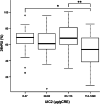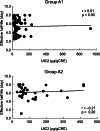Effect of previous administration of potassium iodine and different durations of low iodine diets for radioiodine therapy on the treatment of Graves' disease in iodine-rich areas
- PMID: 38008728
- PMCID: PMC10881611
- DOI: 10.1007/s00259-023-06523-7
Effect of previous administration of potassium iodine and different durations of low iodine diets for radioiodine therapy on the treatment of Graves' disease in iodine-rich areas
Abstract
Purpose: To examine whether adherence to a low-iodine diet (LID) enhances the therapeutic efficacy of radioiodine therapy (RAI) in Graves' hyperthyroidism (GH) in iodine-rich areas.
Methods: We retrospectively evaluated 185 patients with GH from Aichi (n = 114) and Hokkaido (n = 71) Prefectures. Patients aged ≥ 18 years with GH who underwent RAI between December 2012 and March 2022 were divided into subgroups based on pretreatment with anti-thyroid drug (ATD) or potassium iodide (KI). Patients were followed up with LID from 18 days (group A) or 7 days (group H) before RAI to 3 days after RAI. The dose of radioactive iodine 131 (131I) was adjusted to deliver > 100 Gy to the thyroid. The associations between urinary iodine concentration on UIC2 vs. 24hRU and UIC2 vs. the 1-year RAI success rate (SR) were investigated.
Results: Compared with UIC1, UIC2 was significantly decreased in all subgroups (P < 0.01). An inverse correlation between UIC2 and 24hRU was observed in the four groups; however, the difference was insignificant. The SR in groups A and H was 85% and 89%, respectively. Univariate analysis revealed no association between UIC2 and SR in each group. Additionally, stratification of the 185 patients into quartiles using UIC2 yielded no significant differences in SR (p = 0.79).
Conclusions: LID sufficiently reduced UIC in patients undergoing RAI. Although a lower UIC2 may increase 24hRU, it did not increase the success of RAI. The benefit of LID in enhancing the efficacy of RAI in GH treatment remains uncertain.
Keywords: Graves’ hyperthyroidism; Iodine-rich areas; Low iodine diet; Radioiodine therapy; Urinary iodine concentration.
© 2023. The Author(s).
Conflict of interest statement
The authors have no relevant financial or non-financial interests to disclose.
Figures






Similar articles
-
The effect of propylthiouracil on subsequent radioactive iodine therapy in Graves' disease.Clin Endocrinol (Oxf). 1997 Oct;47(4):425-30. doi: 10.1046/j.1365-2265.1997.2741075.x. Clin Endocrinol (Oxf). 1997. PMID: 9404440
-
Efficacy of a fixed low dose of radioactive iodine in the treatment of Graves' disease in Sub-Saharan Africa.Hell J Nucl Med. 2024 Sep-Dec;27(3):176-180. doi: 10.1967/s002449912751. Epub 2024 Dec 9. Hell J Nucl Med. 2024. PMID: 39644268
-
Radioactive iodine therapy for pediatric Graves' disease: a single-center experience over a 10-year period.J Pediatr Endocrinol Metab. 2020 Mar 26;33(3):383-389. doi: 10.1515/jpem-2019-0316. J Pediatr Endocrinol Metab. 2020. PMID: 31603857
-
Radioiodine treatment in pediatric Graves' disease and thyroid carcinoma.J Pediatr Endocrinol Metab. 2011;24(11-12):877-83. doi: 10.1515/jpem.2011.399. J Pediatr Endocrinol Metab. 2011. PMID: 22308835 Review.
-
Radioiodine therapy for Graves' disease: case selection and restrictions recommended to patients in North America.Thyroid. 1997 Apr;7(2):213-6. doi: 10.1089/thy.1997.7.213. Thyroid. 1997. PMID: 9133687 Review.
Cited by
-
Effects of metabolic and organ function factors on the efficacy of radioactive iodine therapy for hyperthyroidism.Front Endocrinol (Lausanne). 2025 Jun 10;16:1568699. doi: 10.3389/fendo.2025.1568699. eCollection 2025. Front Endocrinol (Lausanne). 2025. PMID: 40556833 Free PMC article.
References
MeSH terms
Substances
LinkOut - more resources
Full Text Sources
Medical
Research Materials

